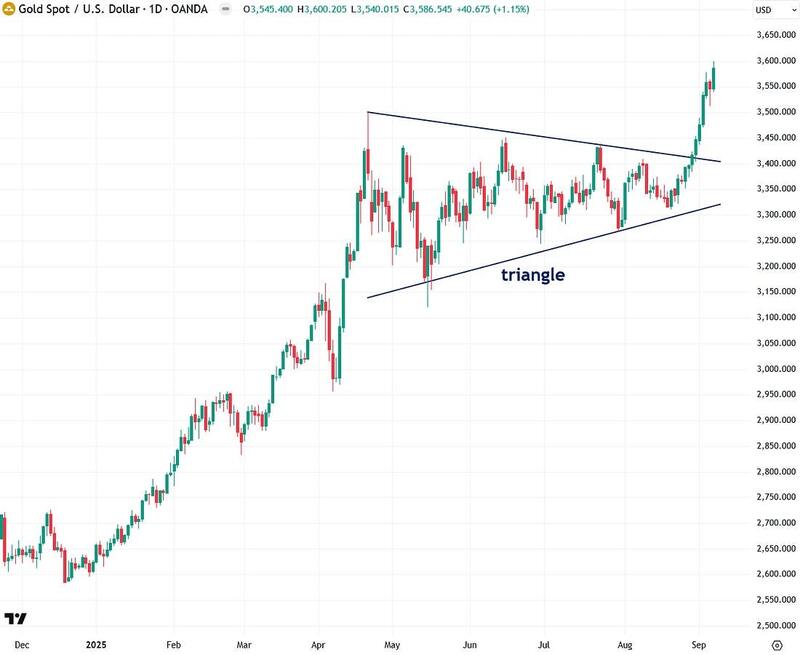The Dollar Is on the Brink of a Major Move
The U.S. dollar is experiencing a rare volatility squeeze, indicating that a major move is near. While the most likely direction is downward, any move will have a big impact on precious metals.
Lately, I’ve been writing a number of updates that follow the theme of “asset X is on the verge of a major move.” I want to be clear that this is not a gimmick or clickbait. I am genuinely seeing credible signs that major moves are approaching across the financial markets.
These signals are not isolated or coincidental but instead reflect a broader underlying pattern. The markets are currently experiencing a massive, collective volatility squeeze as they wait for clarity on several critical economic fronts.
A volatility squeeze is a period of unusually low volatility that leads to a surge in volatility, known as a volatility breakout. These squeezes are important to watch because they frequently precede large market moves.
The clarity that will cause markets to break out of their current volatility squeeze is likely to come from several key developments: growing signs of a potential U.S. recession, expectations for Fed Funds rate cuts, developments related to the stubborn inflation problem, and President Trump’s selection for the next Fed chair.
And it may very well be a combination of all of these factors, which are not mutually exclusive and are closely interconnected.
In this update, I want to alert you to a major move ahead in the U.S. dollar. This move will have far-reaching effects across the financial markets, especially for precious metals and commodities.
So now let’s take a look at the chart of the U.S. Dollar Index, which tracks the dollar’s performance against a basket of major currencies. Since April, the index has been trading in a relatively flat range, and this has led to a developing volatility squeeze.
The squeeze is clearly visible on the chart using the Bollinger Band Width indicator shown just below. If you’ve read my volatility squeeze tutorial linked above, you’ll remember that periods of extremely low volatility typically culminate in major volatility breakouts (which implies significant price moves in the underlying asset).
I believe the dollar is on the verge of one of those big moves.
Not only is the U.S. Dollar Index currently in a volatility squeeze, but it is experiencing one of the most extreme squeezes in recent years. You have to go all the way back to early 2022 to find a comparable example.
That previous squeeze led to an 18% surge in the dollar, which is an unusually large move for the currency market.
Unlike stocks, cryptocurrencies, or commodities, currencies are much less volatile. I believe the current setup is also likely to result in a comparable move.
This time, however, there is a strong probability that the move will be to the downside, as I will explain shortly.
Now that we’ve established that the U.S. Dollar Index is in a volatility squeeze that is very likely to result in a major move, the next step is to examine which direction that move is likely to take by applying several different methods of analysis.
From a technical analysis standpoint, the U.S. dollar remains in a downtrend and in a weak position on the chart, especially after closing below the key 100 level in April and failing to reclaim it.
Although the dollar has been consolidating for the past five months, there is a strong likelihood that it will resume its downward trend once it begins moving again.
From a tactical perspective, the next key step is for the Dollar Index to break down from its consolidation pattern on strong volume. Once that happens, the next leg lower will begin.
A look at the long-term U.S. Dollar Index chart reveals that it has been trading within a rising channel since around 2008.
I believe a breakdown from this channel, which could happen very soon, would be a key signal that the dollar is entering a new bear market, similar to the one that took place in the early 2000s.
Assuming such a breakdown occurs, the next key level to watch is the support at 90. This level was formed by multiple peaks and lows dating back to 2008, making it a critical and long-established level that is likely to draw the index toward it like a magnet.
Another factor that is likely to pull the dollar lower, and that also serves as a useful indicator of which direction the dollar may break, is U.S. Treasury yields. These yields are positively correlated with the U.S. Dollar Index.
When U.S. yields decline relative to bond yields in other countries, the dollar tends to weaken because it is less attractive to move capital into the United States in search of yield.
Conversely, when U.S. yields rise relative to global yields, the dollar typically strengthens as it becomes more appealing for investors to direct capital into the United States.
The chart below shows the U.S. 2-Year Treasury Note yield, which has formed a descending triangle pattern. This is typically a bearish setup and is occurring at the same time as a volatility squeeze, both of which indicate that a significant move in interest rates is likely.
Since Treasury yields are closely tied to the U.S. dollar, any major move in rates should affect the dollar as well.
If the chart breaks down convincingly below the 3.5% support level, it would be a strong signal that both yields and the dollar are heading lower. It would also be a strong indication that a recession is approaching, as I will explain in more detail shortly.
I’ve established that a major move in the U.S. dollar is likely imminent, and the evidence points to that move being to the downside. This would create a strong tailwind for precious metals, given their well-established inverse relationship with the dollar.
Gold and silver have already started to rally after breaking out of their summer consolidations, and further dollar weakness should drive additional gains. I believe this sets the stage for a runup in gold to $4,000 and beyond, and silver to $50 and higher.
Now that I’ve outlined the technical setups pointing to major moves in the U.S. dollar, the euro, Treasury yields, and precious metals, I want to turn to the fundamental drivers likely to fuel these moves.
To get straight to the point, I believe the most powerful potential catalyst is the U.S. economy slipping into a recession.
Moody’s Analytics chief economist Mark Zandi recently issued a high-profile recession call, citing a weakening labor market along with soft consumer spending, construction, and manufacturing data.
Last week brought a wave of disappointing labor reports, starting with the JOLTS report for July, which showed that job openings declined by 176,000 to 7.181 million, marking a 10-month low.
For the first time since the COVID-19 pandemic, there were more unemployed individuals than available positions.
Next was the weekly initial jobless claims report, which revealed a higher-than-expected increase of 8,000 claims, bringing the total to 237,000.
And finally, the trifecta was completed by Friday’s Nonfarm Payrolls report for August, which showed that only 22,000 jobs were added—far below the forecast of 75,000.
With these three weak reports adding to a string of disappointing employment data in recent months, it is becoming increasingly clear that the U.S. is experiencing a job market slump.
As a result, there is now an 87% chance of a 25 basis point Fed Funds Rate cut at the September 17th meeting, while the odds of a 50 basis point cut have doubled over the past week to 9%, according to the prediction market Polymarket.
This is why gold is spiking and Treasury yields are falling, as markets begin pricing in a much more accommodative Federal Reserve in the months ahead.
To summarize, the U.S. dollar and several other important assets, including U.S. Treasuries, gold, silver, and copper, are experiencing volatility squeezes that indicate major price moves are ahead.
The markets are simply waiting for a catalyst, which will most likely come in the form of further confirmation that the U.S. is heading into a recession. Assuming that scenario unfolds, it would cause both Treasury yields and the dollar to decline sharply.
This would, in turn, provide a significant boost to gold, silver, and other commodities, as they trade inversely to the dollar and benefit from dollar weakness.
If you found this report valuable, click here to subscribe to The Bubble Bubble Report for more content like it.
********






















